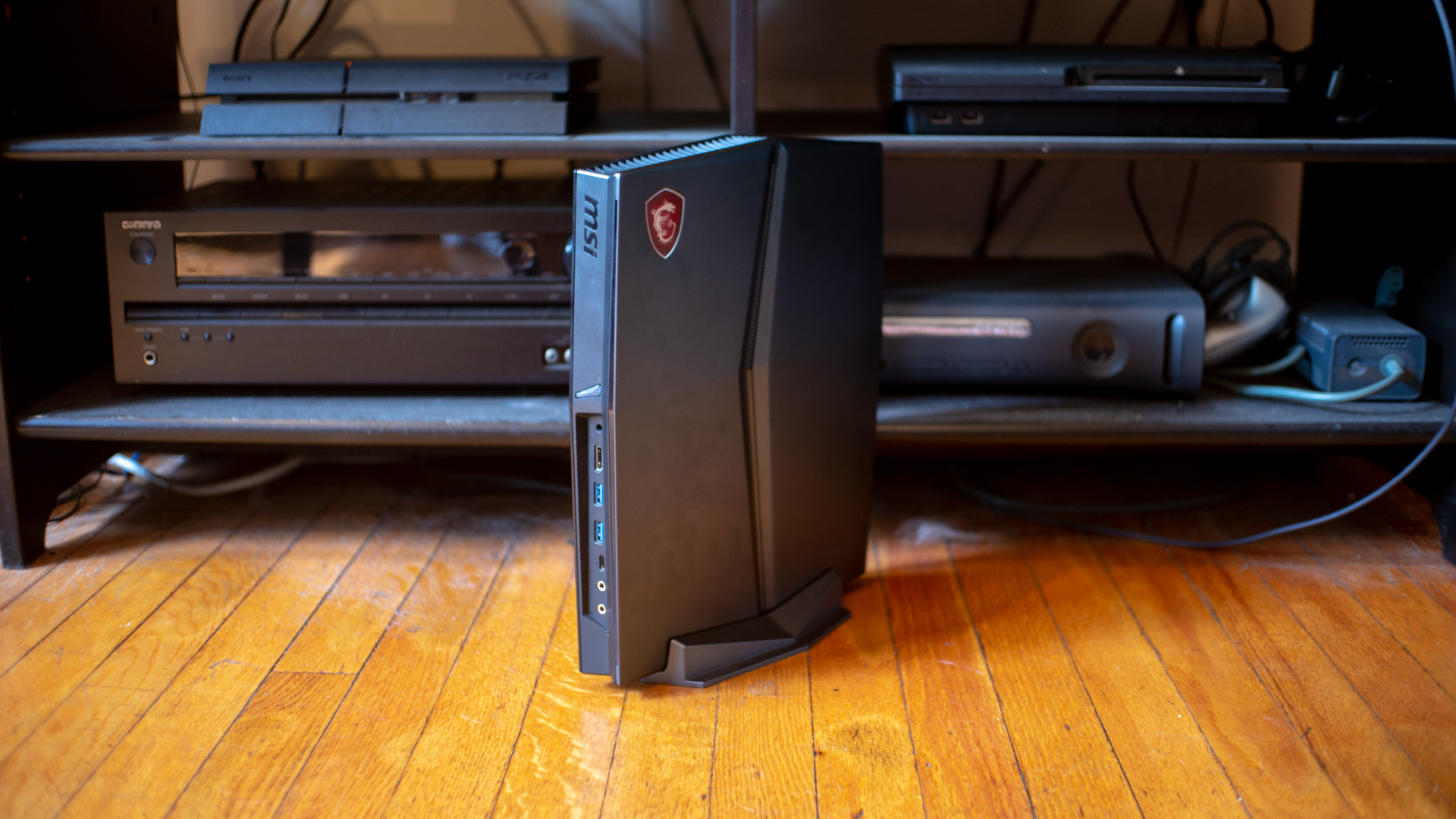TechRadar Verdict
If you need a super small but powerful gaming PC, the MSI Vortex G25 is a worthy champion. But, the high costs and lack of upgradability don’t help it against the competition.
Pros
- +
Small and ultra light
- +
Strong, quiet performance
- +
Multiple mounting options
Cons
- -
Power supply the size of a brick
- -
Limited upgrades
- -
Serious markup for size
Why you can trust TechRadar
The Vortex G25 is MSI’s attempt to pack all the might of a high-performance gaming desktop into a chassis smaller than a video game console. It’s size and weight are unassuming, but inside it has top-shelf components worthy of a proper gaming machine.
The Vortex G25 challenges larger computers admirably, and while performance isn’t greatly sacrificed in making a machine this small, price and upgradability definitely are.

CPU: 3.2GHz Intel Core i7-8700 (six-core, 12MB cache, boost up to 4.6GHz)
Graphics: Nvidia GeForce GTX 1070 (8GB GDDR5)
RAM: 16GB (1x16GB) DDR4 2400MHz
Motherboard: Z370 chipset
Power Supply: 330W external power brick
Storage: 256GB PCIe NVMe Gen3 x4 SSD, 1TB HDD (7,200RPM)
Ports: 1 x USB3.1 Gen2 / DP / Thunderbolt, 1 x USB-C 3.0, 4 x USB 3.0, 1 x RJ45 Ethernet, 2 x HDMI (4K@60Hz), 1 x Mic-in, 1 x Headphone out (HiFi / SPDIF), 1x TOSLINK SPDIF Out, 1 x Kensington Lock, 1 x VR headset power connector
Connectivity: Gigabit LAN, Killer ac Wi-Fi, Bluetooth 4.1
Operating system: Windows 10
Weight: 5.51 pounds (2.5Kg) (excluding power brick)
Size: 13.03 x 1.69 x 10.98 inches (279 x 43 x 331 mm)
Pricing and availability
For the decked out MSI Vortex G25 8RE, the price comes up to $1,999 (£1,999, AU$2,999). The specs and price put it in very close competition with the $1,724 (about £1,230, AU$2,230) Dell XPS Tower Special Edition. It’s also a tough matchup against MSI’s own $1,499 (AU$2,499, about £1,131) Trident 3, which has largely the same specs and a small form factor.
For the price, MSI doesn’t skimp on goodies. A 16GB stick of RAM, 256GB of fast PCIe storage and an extra 1TB of hard drive space are all handy. And, despite its size, it has plenty of ports, including Thunderbolt 3, which can help with extra storage or different video outputs.
The Vortex G25 is available in the US, UK, and Australia, which does give it an edge on the US-exclusive Dell XPS Tower Special Edition. However, shoppers in the UK and Australia can still configure a normal XPS Tower similar machine. The latest version of the Trident 3 doesn’t appear to be available in the UK, but is on sale in the US and Australia.
The Vortex G25 also comes specced out in two models, with a cheaper $1,499 (about £1,140, 2,030) G25 8RD packing an Intel Core i5-8400 and Nvidia GeForce GTX 1060 and the Vortex G25 8RE we tested coming loaded with a Core i7-8700 and GeForce GTX 1070. The two versions are mostly the same otherwise.
For a clear comparison, the Dell XPS Tower Special Edition and Trident 3 we’ve selected both come with a Core i7-8700 processor, a GTX 1080 with 8GB of VRAM, 16GB of DDR4 memory, and a paired 256GB of PCIe NVMe SSD and 1TB of hard drive storage.
Sign up for breaking news, reviews, opinion, top tech deals, and more.
Though that puts the competition close, size is as much of a deciding factor for the G25 as the components inside it.

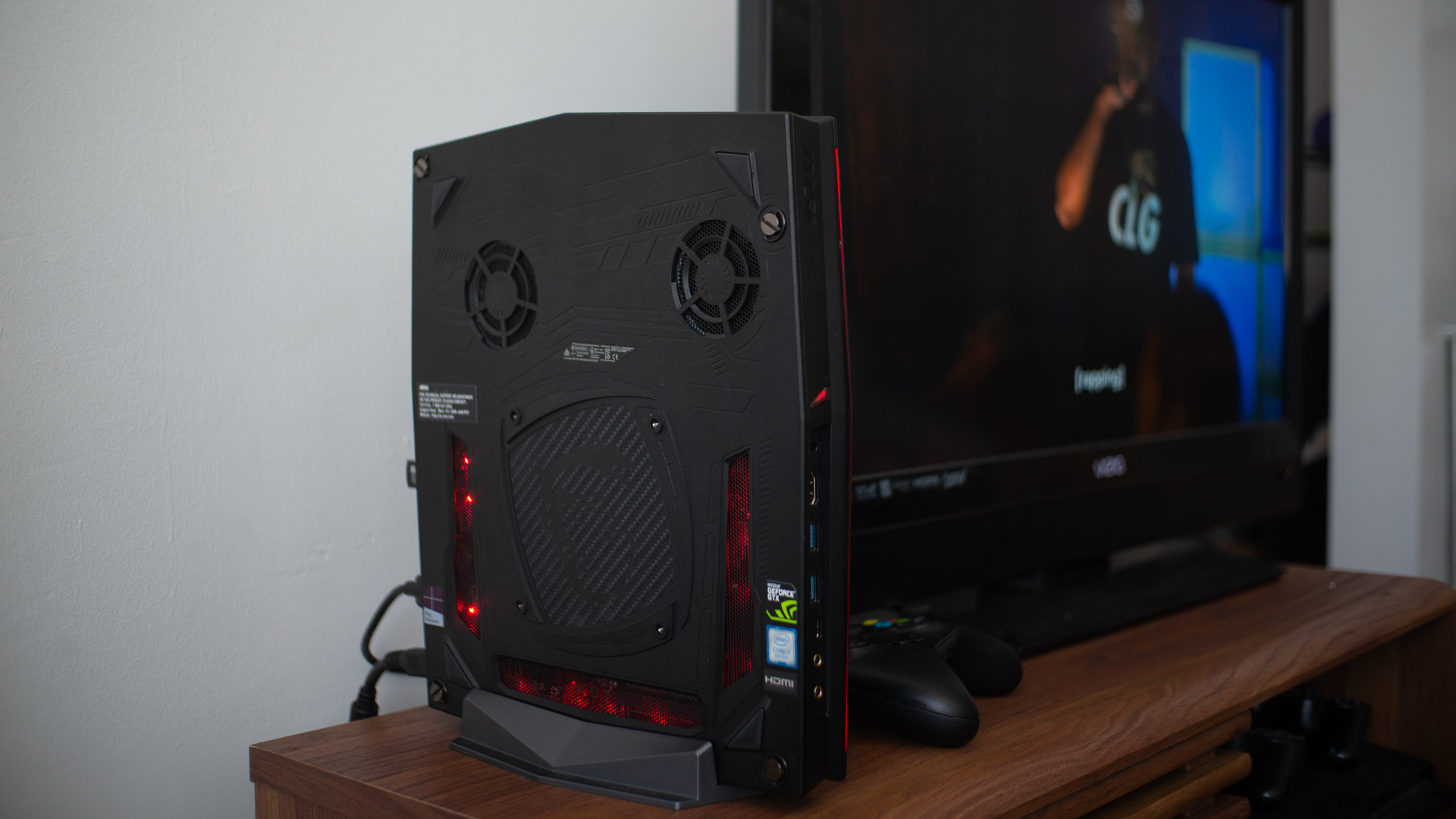
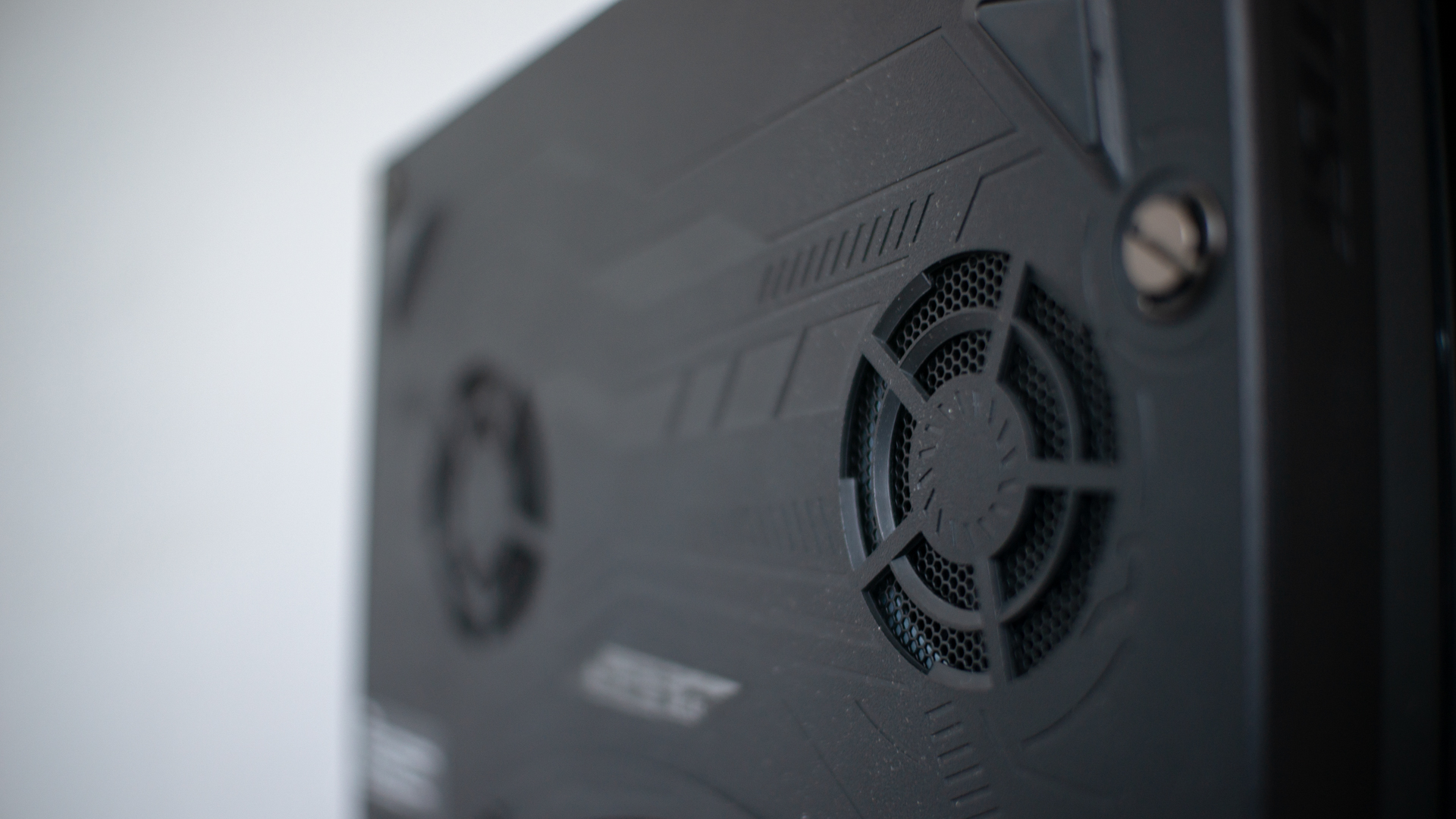

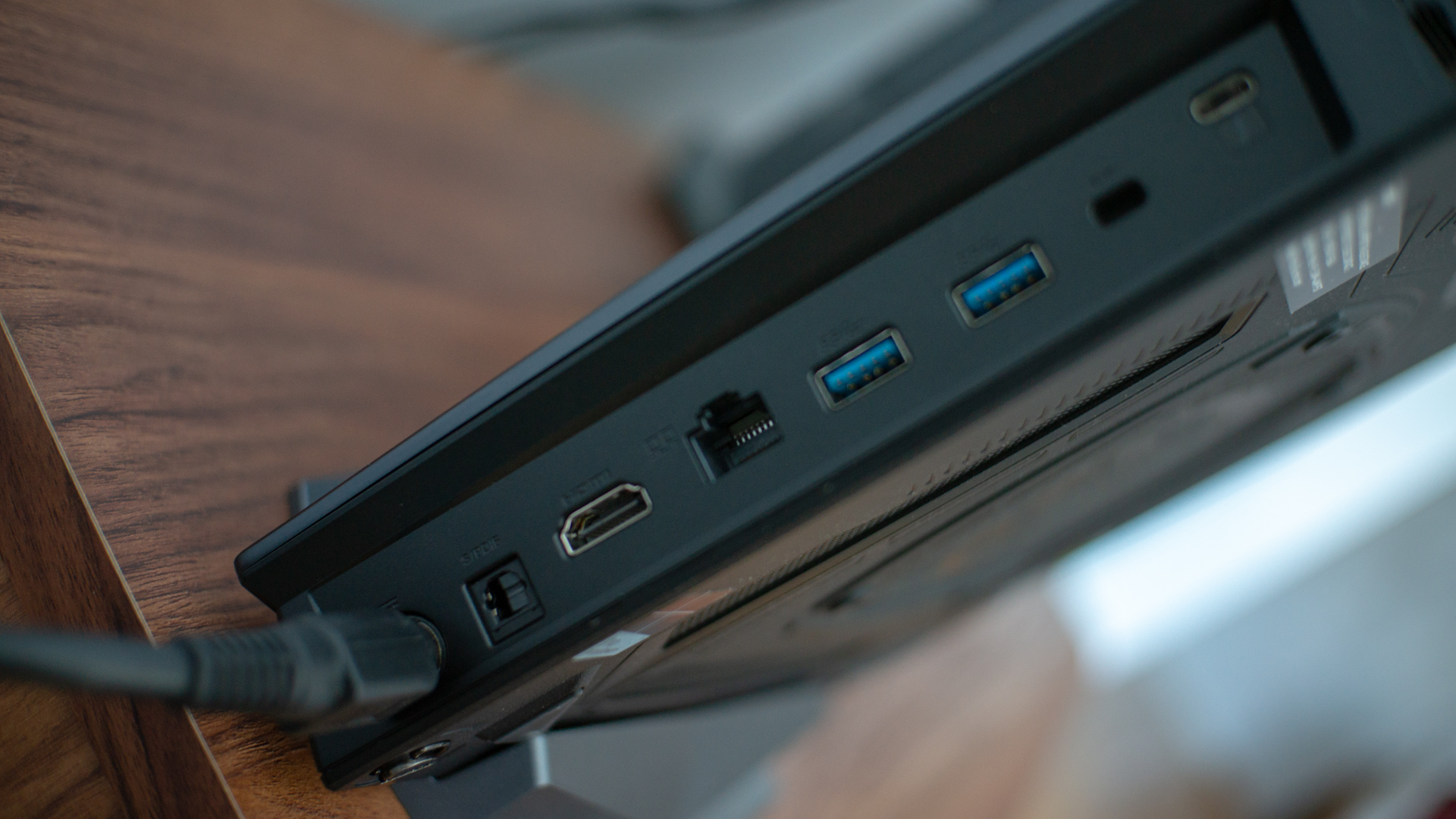
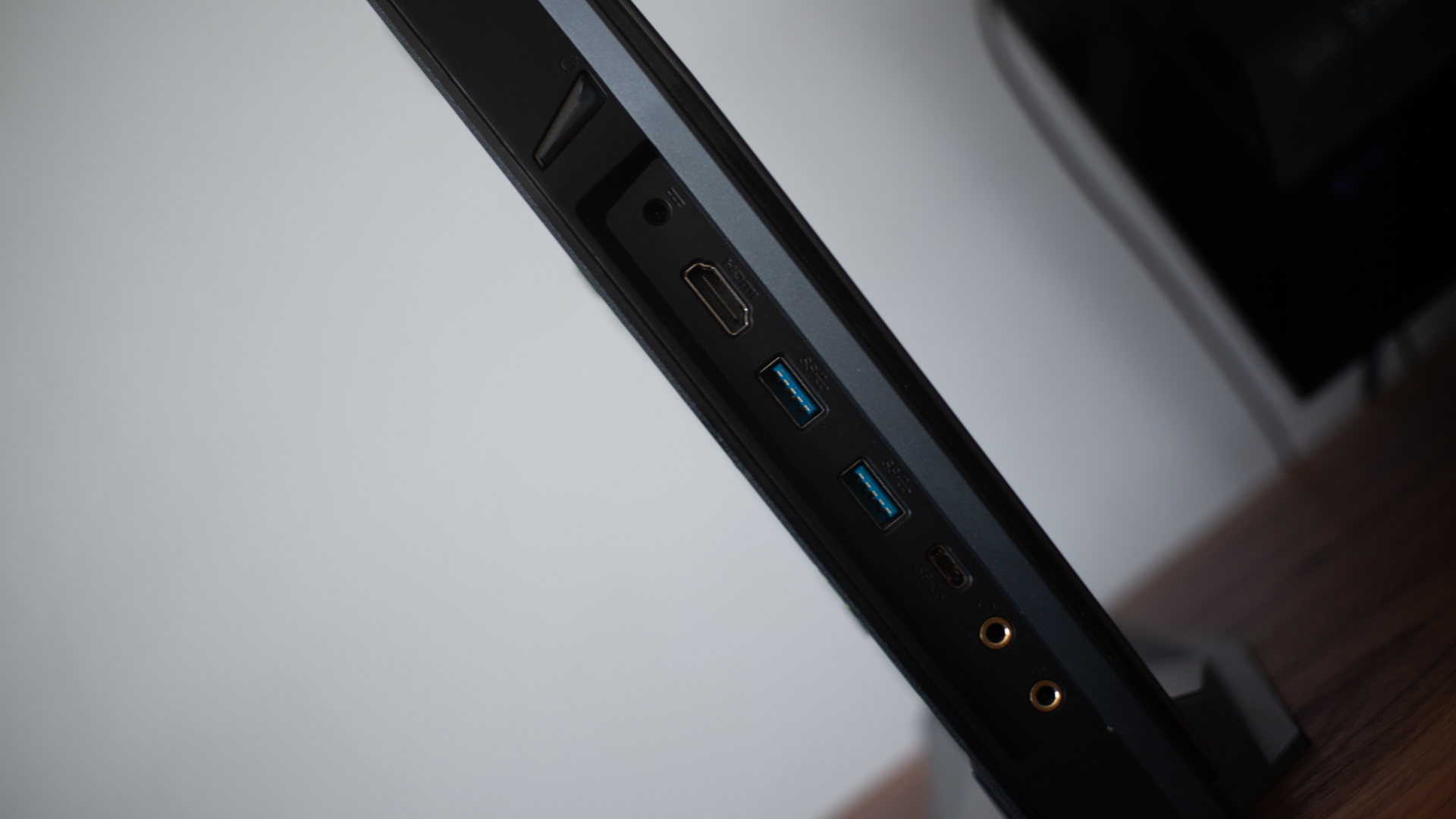


Design
Since the MSI Vortex G25 8RE is a gaming computer, the components inside are a key element. But, anyone can slap together high-end parts and call it a gaming computer. The selling point of the Vortex G25 is really the design.
MSI has made this computer incredibly compact. Sitting it next to a PS3 Slim, it’s immediately apparent how far gaming machines have come over the years. It’s not only smaller than the PS3, but also more powerful by a wide margin.
The Vortex G25 measures in at a slim 13.03 x 1.69 x 10.98 inches, which doesn’t feel much bigger than a college textbook or binder. And, at just 5.51 pounds, it doesn’t feel anything like the sorts of desktop computers that we’re used to picking up. In form factor, this one is designed much more like a console or a gaming laptop than the typical gaming PC.
It’s handy that USB-A and USB-C ports as well as HDMI are all available on the front and the back, especially for a VR setup. We’re extra glad that the power connector is close to the corner, since the hefty cable would otherwise get in the way of other cables running out of the back. Though the USB-C port does provide the option of a DisplayPort connection, it would be nicer to have that option without extra dongles.
The small design does unfortunately mean that the power supply is not built into the case. So you’ll have a power brick hanging out somewhere in your setup or in your backpack when you’re on the go. And, when we say brick, in this case it’s not just a metaphor. The power supply is roughly the same size and weight of a brick we just happen to have sitting around.
The aesthetic of the MSI Vortex is fairly gamery, with an angular look, multiple independently lit RGB zones, some carbon fiber styling on the bottom, and MSI’s dragon emblem on the top. It’s not overdone though, and the option to turn off the lighting can help if you want a low key look.
The Vortex G25 can sit flat or stand vertically with a provided mount. Stability feels like a worthwhile concern in the vertical position, but only if you’re prone to yanking on wired controllers or might trip over cables that aren’t tucked away. The computer is also compatible with VESA mounts, so it can even hide away behind a TV or monitor.

Upgradability
Unsurprisingly, the small, laptop-level thin form factor of the Vortex G25 doesn’t lend to upgradability. MSI might like to make you think otherwise, as it gives the computer tool-less screws, but inside, there’s really little in the way of upgrades possible.
Popping off off the back (which actually can require a screwdriver because the thumbscrews may be threaded in a bit tight and the plastic backplate has a lot of tough latches) reveals the only clear upgrade path is the system memory.
There’s one 16GB stick of RAM populating the computer’s four SO-DIMM slots (yes, laptop-style memory). On the plus side, MSI’s thoughtful configuration here means the computer can be upgraded to 64GB of RAM without having to throw out the original stick of RAM.
While we won’t rule out the possibility of upgrading more parts of the computer, it doesn’t look easy. With the back panel off, even the internal storage isn’t readily accessible. Trying to swap the CPU would take a fair bit more than the typical PC-building know-how to accomplish.
Thunderbolt 3 does offer a viable, if not quite compelling, way to increase the storage or even to use an external GPU enclosure in the future, but those sizable add-ons to the rig really defeat the purpose of buying the Vortex G25.

Here’s how the MSI Vortex G25 8RE performed in our suite of benchmark tests:
3DMark: Sky Diver: 35,558.5 ; Fire Strike: 14,695 ; Time Spy: 5,532
Cinebench CPU: 1073 points; Graphics: 138.78 fps
GeekBench: 5180 (single-core); 19927 (multi-core)
PCMark 8 (Home Test): 4980 points
Total War: Warhammer II (1080p, Ultra): 54.6 fps; (1080p, Low): 111.2 fps
Middle Earth: Shadow of War (1080p, Ultra): 78 fps; (1080p, Low): 148.3 fps
Performance
At first, performance may seem like a serious concern for a small form-factor PC. With powerful gaming laptops, cooling can be a big issue, as can the thermal throttling that comes with it. Given the MSI Vortex G25’s slim build, we guessed we’d be seeing some of that, but MSI manages the airflow well, and we see truly admirable desktop performance from it.
The computer turns on in the blink of an eye and launches programs quickly. In our use, it never so much as hiccuped. In our gaming benchmarks, it performs on an even footing with the Dell XPS Tower Special Edition. We also get buttery smooth Quad HD gameplay varying between 70 and 100fps in Wolfenstein II: The New Colossus playing at with maxed settings and the FOV turned up.
In other benchmarks, the Vortex G25 falls behind a little bit here and there. But, some of that may be related to the Windows 10 April Update that dropped earlier this year loaded with bugs.
Still, the Vortex G25 performs well. Perhaps most surprising is that even when it’s working hard and the fans are doing their thing, it doesn’t sound like a leaf blower. Yes, it’s audible, but it’s not whining or roaring. It also doesn’t feel like a space heater, nor do we notice performance suddenly dropping after a few hours of gaming have given it a good chance to heat up.

Final verdict
The MSI Vortex G25 8RE is a high-performance desktop that can clobber any gaming console while taking up less space. That’s no small accomplishment, but at $1,999, it comes at no small price. For anyone that wants a super small, but potent gaming computer though, it may be worth it.
Bigger computers with similar specs will cost less, have more pathways for future upgrades, and be less likely to get congested with dust that’s hard to clean out. But, they will take up much more space. What type of computer fits for you will determine whether the trade-offs are worth it. If they are, then the MSI Vortex G25 8RE is a perfectly good pick.
However, anyone that wants small but doesn’t need to go quite as small as the Vortex has an easy alternative in the MSI Trident 3. The latest models have equivalent internals, have a more clear upgrade path (the GPU is actually a mini-sized PCIe graphics card), still come in a console-like form factor, and cost 25% less.

Over the last several years, Mark has been tasked as a writer, an editor, and a manager, interacting with published content from all angles. He is intimately familiar with the editorial process from the inception of an article idea, through the iterative process, past publishing, and down the road into performance analysis.
